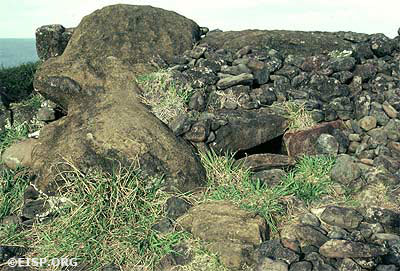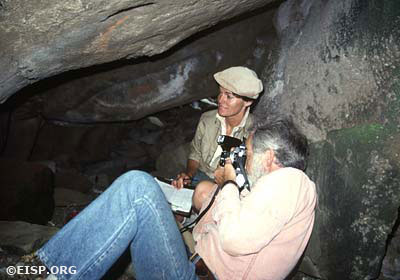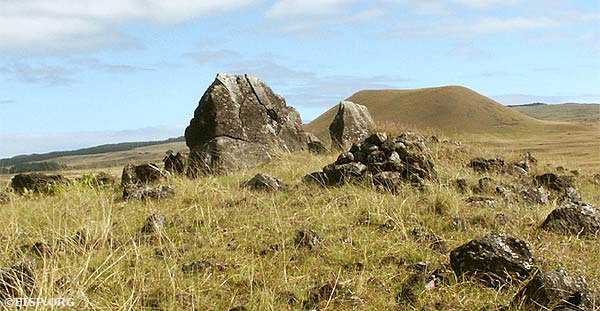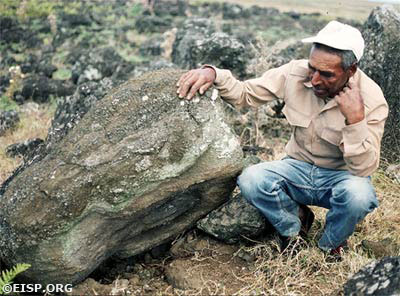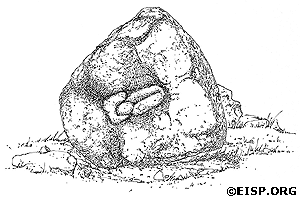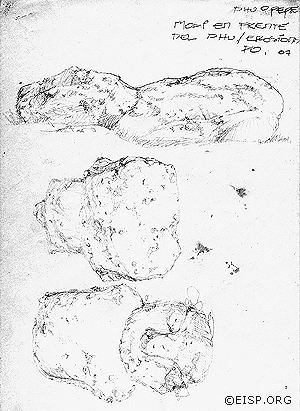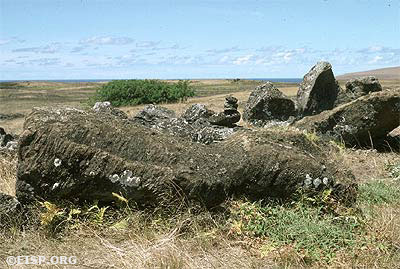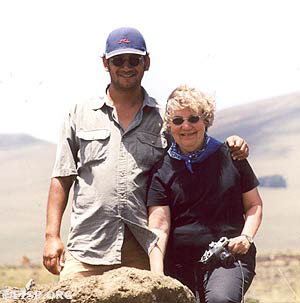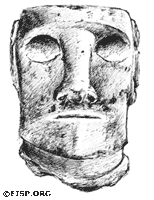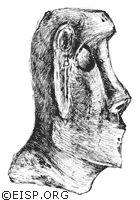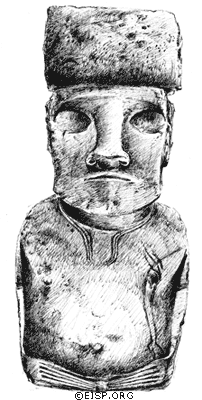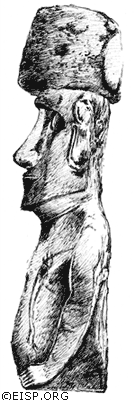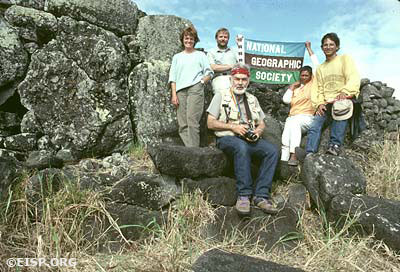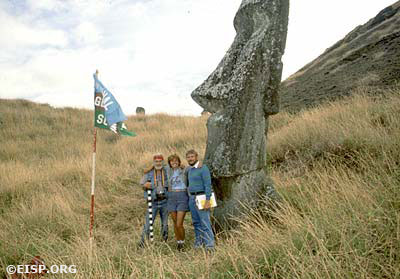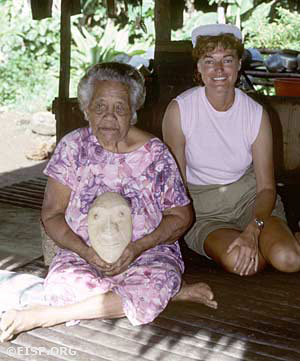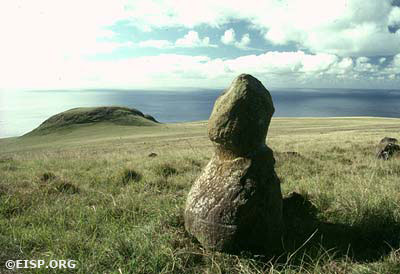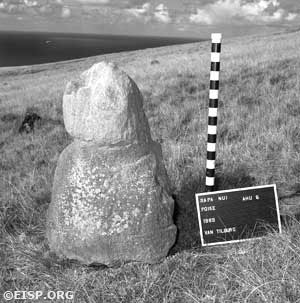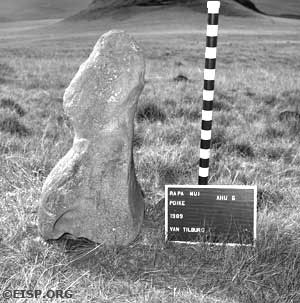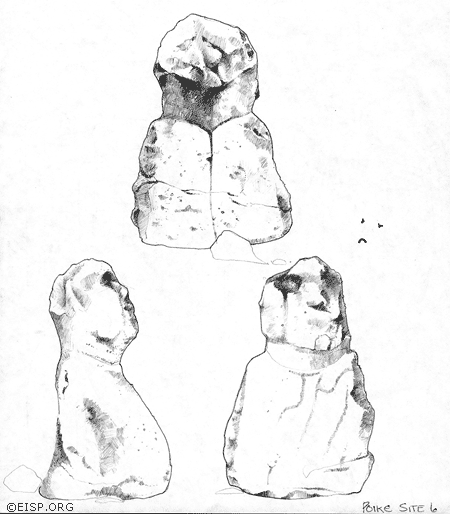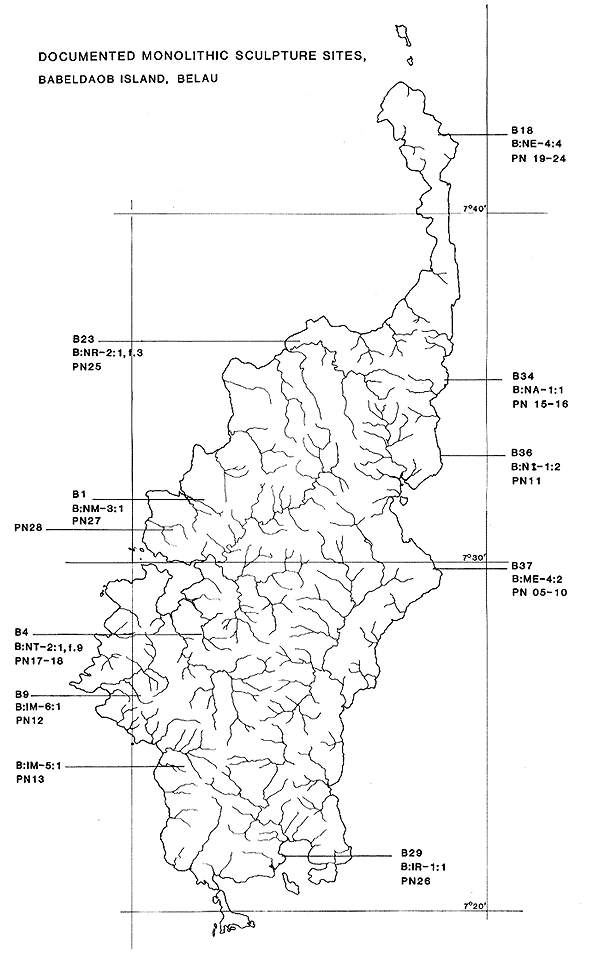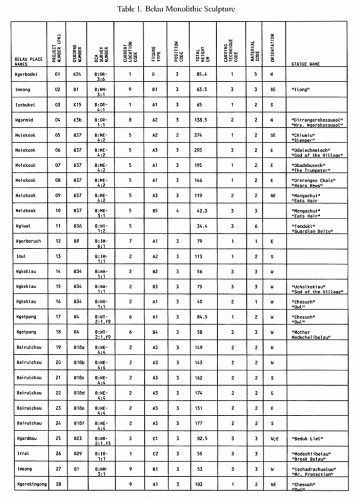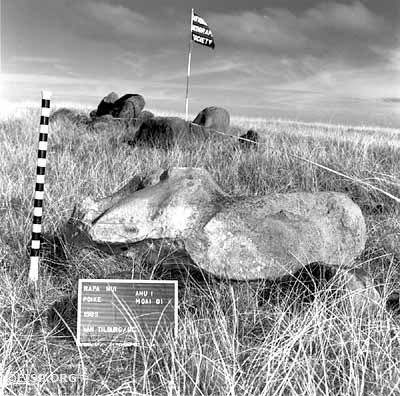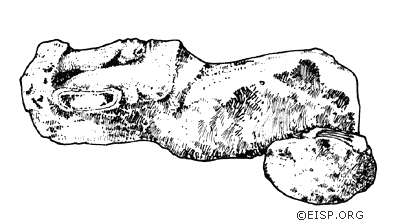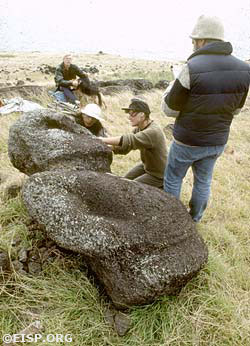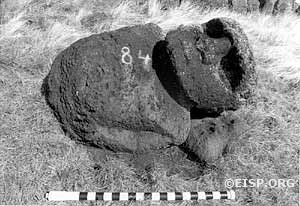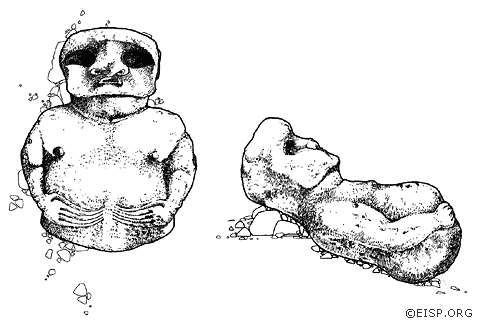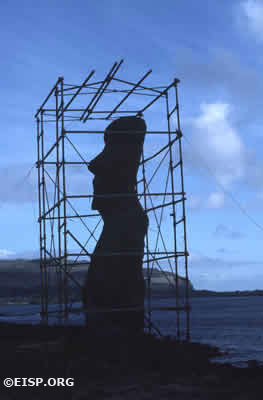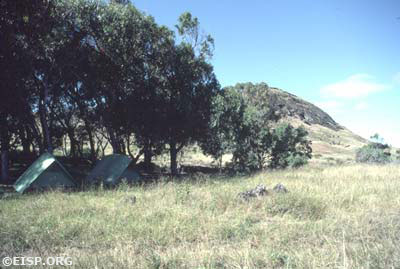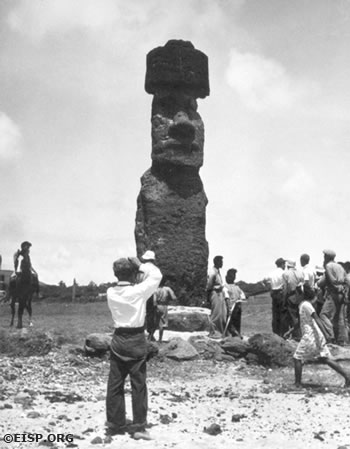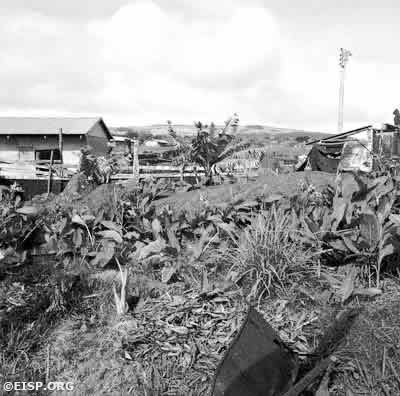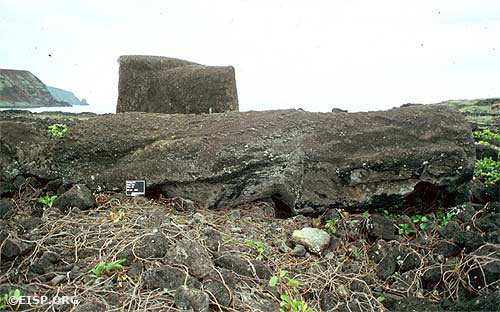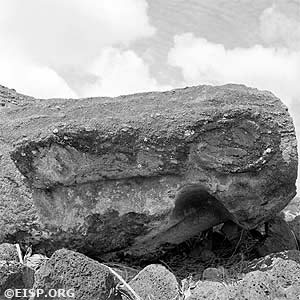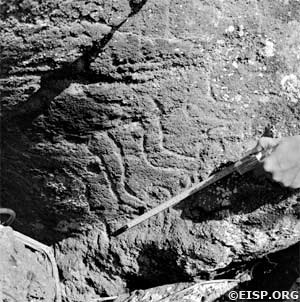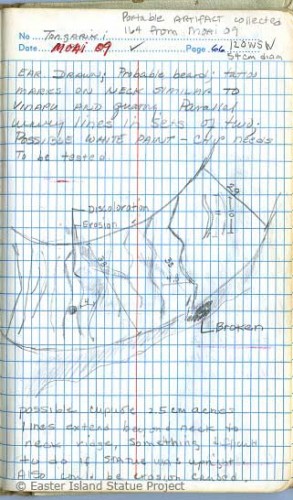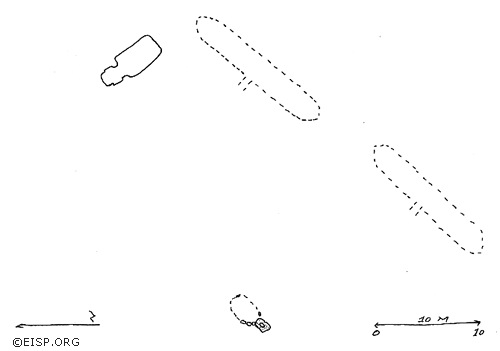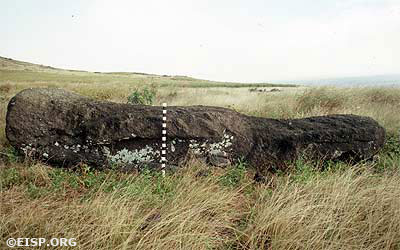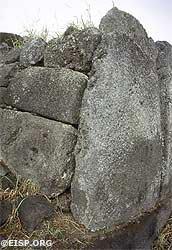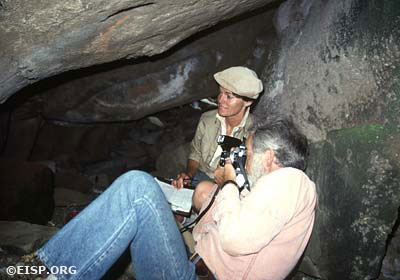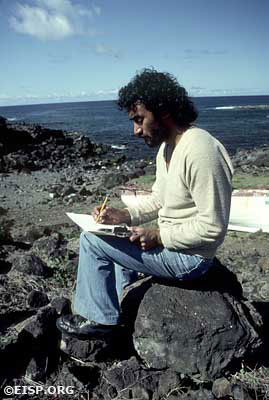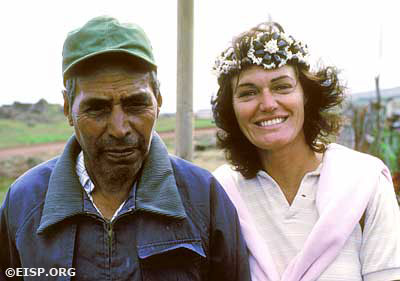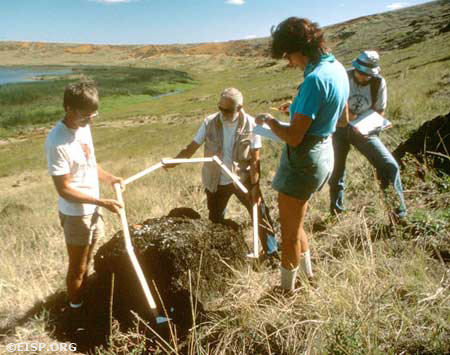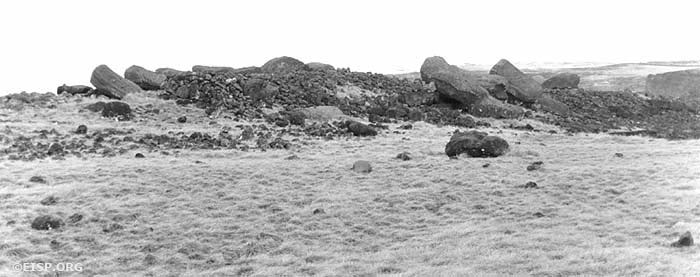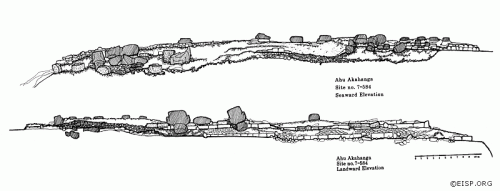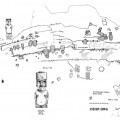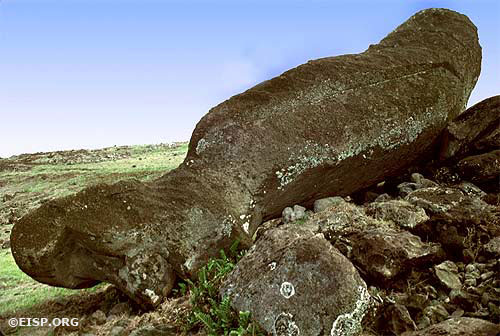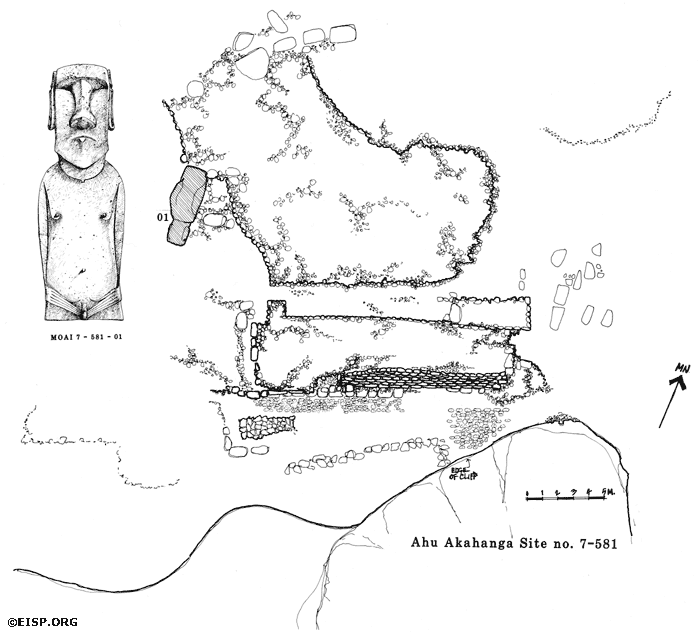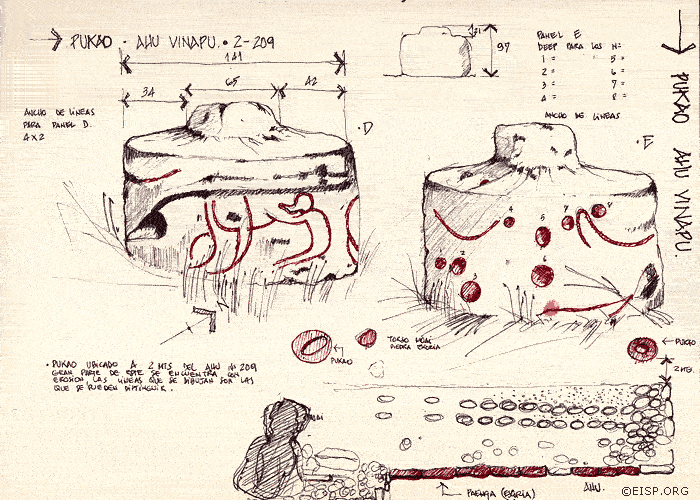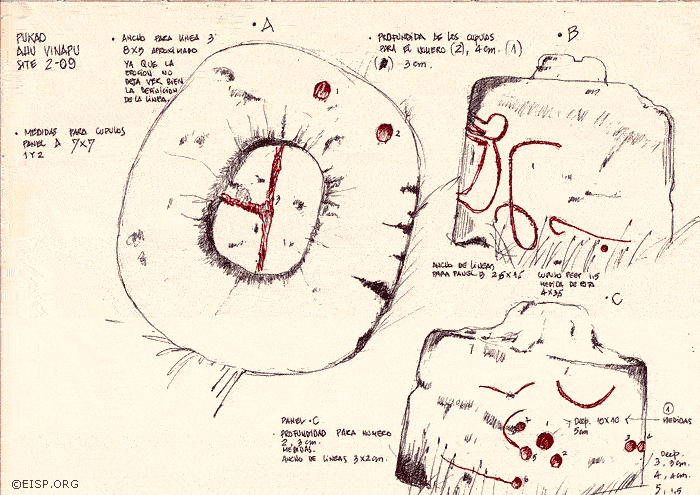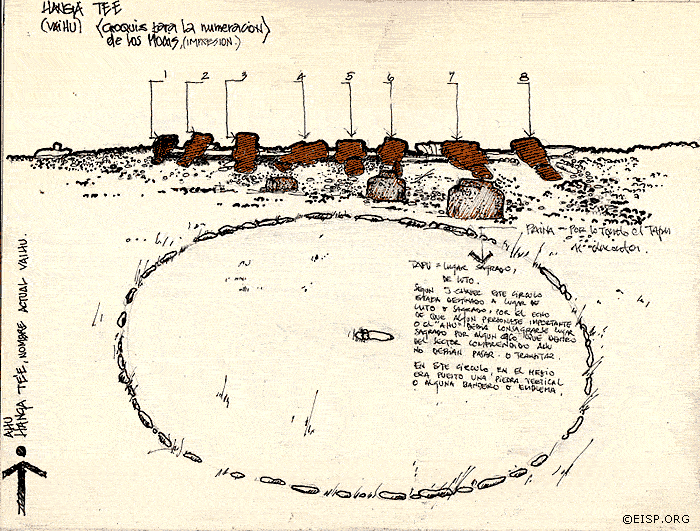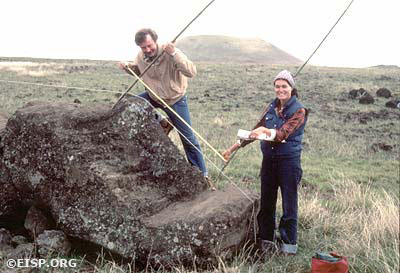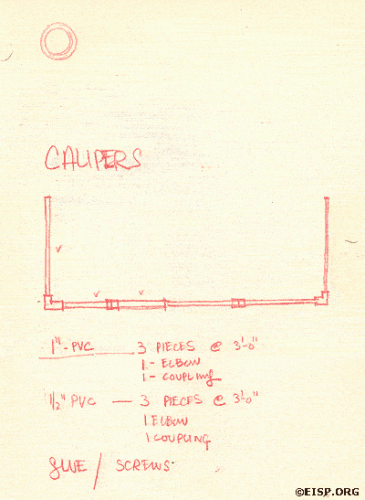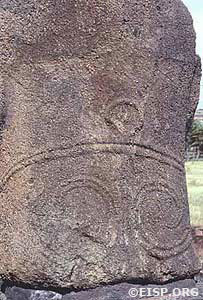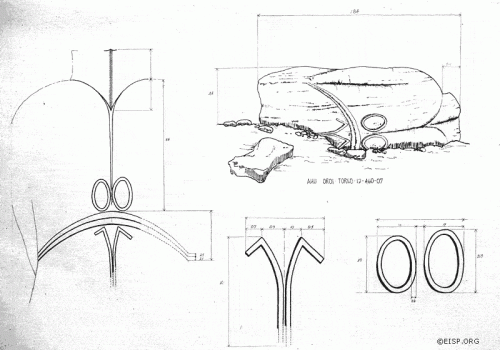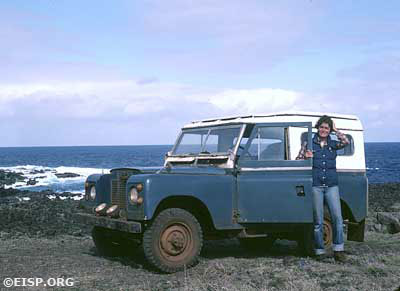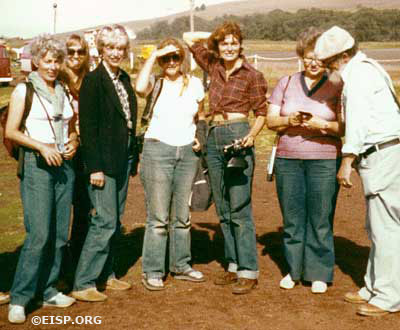Easter Island Statue Project Official Website : 1980s (original) (raw)
Ahu Vinapu: Moai 02-210-004
Moai 02-210-004.
Jo Anne Van Tilburg and EISP photographer David C. Ochsner on site at Vinapu. © EISP/JVT/Photo: M.A. Clark.
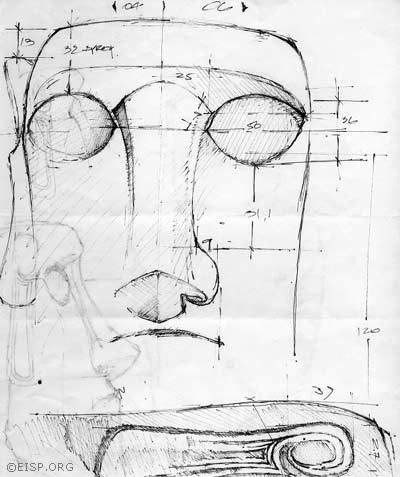
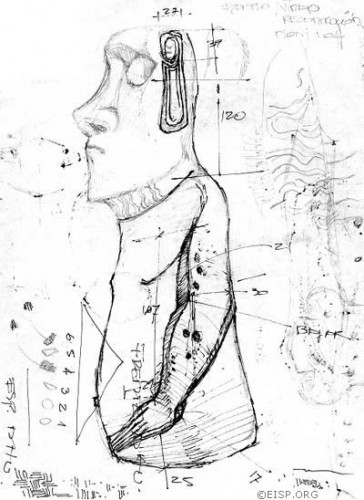
 (left) This statue illustrates the ceremonial use of a fallen moai into historic time. The site was excavated by W. Mulloy and reported in the published papers of the Norwegian Archaeological Expedition. Although there were some anomalies in the descriptions of the statues, Mulloy’s team also produced a conjectural reconstruction view of the statues standing upright on the platform.
(left) This statue illustrates the ceremonial use of a fallen moai into historic time. The site was excavated by W. Mulloy and reported in the published papers of the Norwegian Archaeological Expedition. Although there were some anomalies in the descriptions of the statues, Mulloy’s team also produced a conjectural reconstruction view of the statues standing upright on the platform.
RELATED RECORD: See Raúl Paoa’s sketches, which were used as the basis of the pukao in this reconstruction.
Posted on May 8th, 2009 by EISP Staff | Categories: 1980s, Field Notes & Documents |
Statue Shape Variation
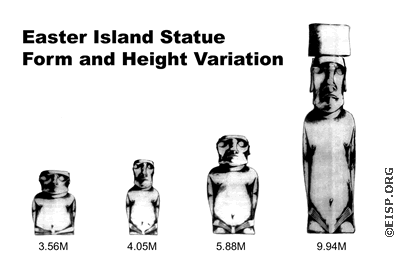 Statue type category examples.
Statue type category examples.
©EISP/JVT/Drawing: Cristián Arévalo Pakarati.
Posted on May 5th, 2009 by EISP Staff | Categories: 1980s, Field Notes & Documents |
Ahu O’Pepe 20-001
Ahu O'Pepe (20-001), an inland ahu, once held seven moai and as such may be compared to Ahu Akivi (16-001).. © 2003 EISP/JVT/Photo: A. Perlin.
Felipe Teao A. with a torso, recarved into bas-relief komari (vulva). ©1987 EISP/JVT/Photo: D. C. Ochsner.
Drawing of moai Torso 20-001-006 recarved as a bas-relief komari (vulva), Ahu O'Pepe©1991 EISP/JVT/Drawing: C. Arévalo P.
Field drawings document Moai 20-001-013 of Ahu O'Pepe. ©1991 EISP/JVT/Sketch: C. Arévalo P.
Moai 20-001-013 in situ at Ahu O'Pepe. ©1987 EISP/JVT/Photo: D. C. Ochsner.
Cristiàn Arèvalo Pakarati, with Dr. Adrienne L. Kaeppler, curator at the NMNH.
Posted on May 5th, 2009 by EISP Staff | Categories: 1980s, 2000s, Field Notes & Documents |
Smithsonian Moai SI-WDC-001
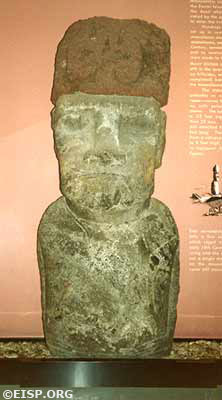
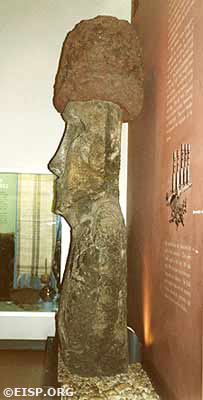
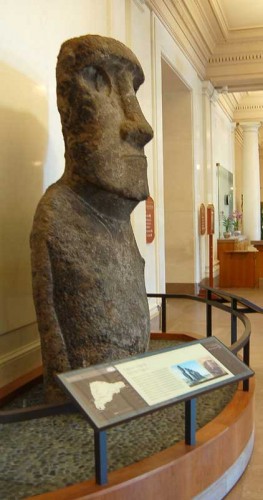 (far left, 2 images) EISP archive photos of Moai SI-WDC-001, located at the Smithsonian Institution in Washington DC, USA. Photos by Jo Anne Van Tilburg, 1986 © JVT/EISP.
(far left, 2 images) EISP archive photos of Moai SI-WDC-001, located at the Smithsonian Institution in Washington DC, USA. Photos by Jo Anne Van Tilburg, 1986 © JVT/EISP.
(left) Moai SI-WDC-001 is currently installed inside the Constitution Ave. entrance of the National Museum of Natural History, Smithsonian Institution in Washington D.C.
EISP archive drawings of Head SI-WDC-002 and MoaiSI-WDC-001, both originally from Ahu O’Pepe, are currently in the collection of the Smithsonian Institution. Drawings by Cristián Arévalo Pakarati, 2000© JVT/EISP.
RELATED RECORD: Cristiàn Arèvalo Pakarati, Rapanui artist and EISP co-investigator with Dr. Adrienne L. Kaeppler, curator of oceanic ethnology at the National Museum of Natural History, Smithsonian Institution, on site at Ahu O’Pepe.
Posted on May 4th, 2009 by EISP Staff | Categories: 1980s, Field Notes & Documents, Museum Objects Inventory |
Easter Island Statue Project History: 1989
Goals and Methods
David C. Ochsner, Jo Anne Van Tilburg, Curtiss H. Johnson, Luisa Fati, Cristián Arèvalo Pakarati (and the National Geographic Society flag), Vai Mata, Rapa Nui. Photo by David C. Ochsner, © JVT/EISP.
The specific archaeological purpose of the Easter Island Statue Project, since its inception, is to inventory the statues throughout the island. The method used to accomplish this goal is that of archaeological survey. During the inventory process, the statues are described through the documentation of metric attributes, but also through statistical evaluation of volume, cross sectional area, and center of gravity. We employ a standardized recording format and use special, large-scale calipers or measuring devices. The model for this type of work is found in a wide range of artifact studies, including lithics or pottery analysis and osteometrics.
This post-dissertation research was funded by the National Geographical Society. It was meant to extend the statue site aspect of the generalized archaeological survey to the north and west coasts, Anakena to Vai Mata (quadrangles 26, 32, 33, 34, 35), and to the Poike peninsula (independently being surveyed at about the same time by the University of Chile). We hoped to correct inconsistencies discovered in one or more of eight key measurements on forty-eight statues. If time permitted, we would document the statues on the restored site of Ahu Akivi for comparison and validation studies.
David C. Ochsner, Jo Anne Van Tilburg, Curtiss Johnson (and National Geographic Society flag), Rano Raraku, Rapa Nui (Easter Island). Photo by David C. Ochsner, © JVT/EISP.
In terms of furthering our interest in ahu design and construction, we intended to collect measurements of ahu platform lengths to establish the range of structural size and scale related to statue size and number, and to produce maps and plans of ahu construction variation. Based on our previous fieldwork and discoveries related to the use of red scoria, we wanted to document the occurrence or non-occurrence of red scoria as cornerstones and architectural enhancement. Finally, we had formulated questions about siting and previous construction on ahu sites, and planned to produce elevations showing the variation in seaward and landward wall construction.
[Read More…]
Posted on May 4th, 2009 by Jo Anne Van Tilburg, Ph.D. | Categories: 1980s |
Fieldwork on the Islands of Oreor and Babeldaob, Republic of Belau (Palau), Micronesia, 1987
Jo Anne Van Tilburg and an elder of the Babelblai family of Ngiwal. ©1987 EISP/JVT/ Photo: D. C. Ochsner
In 1987 we were drawn to Belau by a statue described by archaeologist Douglas Osborne, who had worked there in the 1960s, as “strikingly like those of Easter Island.” Although he said it was “more conventionalized” and “less naturalistic” than Easter Island sculpture, the possibility that it resembled moai was intriguing, and we undertook eight weeks of intensive field survey work in the Republic of Belau (Palau). Our intent was to collect data on the formal and stylistic qualities of the statue Osborne had described, and then to record any others we might find. The aim was to gather enough data to constitute one component of a comparative study of Pacific monolithic stone sculpture.
Stone statues or monuments in Belau are one of ten elements that define Level 1, a “village settlement system” of a two level settlement system research model. Archaeologists conducting island-wide surveys have classified artifacts, areas, or features into three categories: discrete portable objects (potsherds, chipped and ground stone); discrete non-portable features (platforms, statues, uprights); and non-discrete, non-portable areas (terraces). [Read More…]
Posted on May 4th, 2009 by Jo Anne Van Tilburg, Ph.D. | Categories: 1980s, Comparative Studies |
Trachite Statue, Poike
Trachite statue, Poike, Rapa Nui (Easter Island), 1989. Photos by David C. Ochsner, drawings by Cristián Arévalo Pakarati © JVT/EISP.
Posted on May 4th, 2009 by EISP Staff | Categories: 1980s, Field Notes & Documents |
Palau Statue Survey Map & Data Table: 1987
Location of monolithic sculpture sites recorded during our 1987 fieldwork on Babeldaob island, Republic of Belau, Micronesia.
Table listing twenty-eight stone monoliths recorded during our 1987 fieldwork in Belau, Micronesia. Project number 27 was said to resemble Easter Island sculpture.
Posted on May 4th, 2009 by EISP Staff | Categories: 1980s, Comparative Studies, Field Notes & Documents |
Trachite Statue, Ahu 1, Poike
EISP archive photo of trachite statue (on Ahu 1), Poike, Rapa Nui (Easter Island), 1989. Photo by David C. Ochsner, © JVT/EISP.
EISP archive drawing of trachite statue (on Ahu 1), Poike, Rapa Nui (Easter Island), 1989. Drawing by Cristián Arévalo Pakarati, © JVT/EISP.
Posted on May 4th, 2009 by EISP Staff | Categories: 1980s, Field Notes & Documents |
Basalt Statue, PSE 84
EISP crew Noemi Pakarati, Jo Anne Van Tilburg, Curtiss H. Johnson (J. Weber in the background) documenting the basalt Moai 84, Rapa Nui (Easter Island), 1989. Photo by David C. Ochsner, copyright JVT/EISP.
EISP archive photo of basalt Moai 84, Rapa Nui (Easter Island), 1989. Photo by David C. Ochsner, copyright JVT/EISP.
EISP archive drawing by Cristián Arévalo Pakarati of basalt Moai 84, Rapa Nui (Easter Island), 1989.
Posted on May 4th, 2009 by EISP Staff | Categories: 1980s, Field Notes & Documents |
Easter Island Quadrangle Map
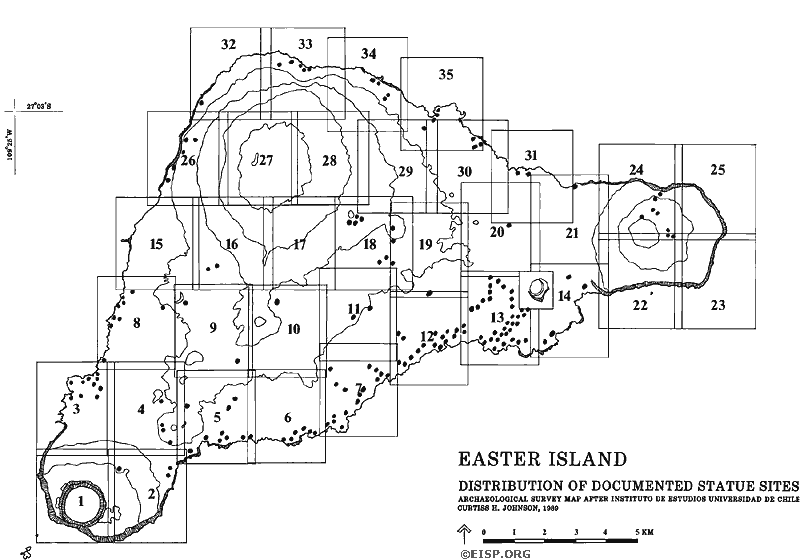 Map showing the distribution of documented statues and statue sites to 1989. Archaeological survey quadrangles after the University of Chile. EISP data. Drafting by Curtiss H. Johnson, 1989.
Map showing the distribution of documented statues and statue sites to 1989. Archaeological survey quadrangles after the University of Chile. EISP data. Drafting by Curtiss H. Johnson, 1989.
Posted on May 4th, 2009 by EISP Staff | Categories: 1980s, Field Notes & Documents, Moai Inventory |
Easter Island Statue Project History: 1985-1988
Goals and Methods
Stone surface conservation experiment conducted at Hanga Kio'E by Chilean museum authorities. ©1986 EISP/JVT/ Photo: J. Van Tilburg.
Data compilation and analysis, augmented by numerous field trips to the island and by museum study, were the primary goals of this period of research. The data were filed in what was, for the time, a rather sophisticated management program. The files have since been edited and transferred to other programs, however. All visual materials, including thousands of slides, black and white photographs, and negatives; hundreds of field sketches, notes, and maps were all organized within archival-safe storage. This effort, which was tedious at the time, was essential to proper use of the data, and laid the groundwork for the creation of the most comprehensive moai documentation archive in existence.
The specific task was to describe the moai as an archaeological artifact. Statue types were defined by shape of body and of head. A maximum-minimum size range for each type was defined and volume was calculated. Each type was a basic and discrete unit. Stylistic variations were outlined for such characteristics as hands, eyes, ears, and the dorsal design. The latter consisted of the hami(loincloth), maro (belt), and other related incised and bas-relief elements.
Specific research goals then could employ statue types to examine statue distribution and chronological relationships relative to the size and location of lineage centers, and to the presence or absence of pukao on ahu sites. Statue type, it was hypothesized, would relate to ahu construction type, and statue style sequence within the largest lineage centers would relate to ahu chronology.
At this time, the overwhelming weight of cumulative archaeological and linguistic evidence clearly supported an East Polynesian origin for Rapa Nui culture. This suggested that the sculptural emphasis that had been placed upon specific statue design components would be understandable within the ideological context of the Polynesian world view. Moai were presumed to be symbols of a dominant socio-political system defined as male, hierarchical, and lineage-based. Further, an understanding of the role of the statues as a legitimating symbol in the dominant ideology involved an appreciation of the existence of a subordinate ideology incorporating bird and other symbols. [Read More…]
Posted on May 4th, 2009 by Jo Anne Van Tilburg, Ph.D. | Categories: 1980s |
Easter Island Statue Project History: 1984
EISP camp, Rano Raraku. ©1984 EISP/JVT/ Photo: D. C. Ochsner.
Goals and Methods
The combined fieldwork of the 1982 and 1983 field seasons described approximately 300 statues and mapped seven major ahu sites. All of the surveyed and mapped quadrangles were included in the study area, and most were exhaustively examined. Data were sampled from selected unmapped areas of the island.
As the third season of the Easter Island Statue Project began, our data analysis clearly showed that:
- Morphological and stylistic attributes can be defined metrically and illustrated graphically. They sufficiently describe statue shape variation.
- There are four general geographic loci in which statues are found. These loci may be further divided into sub-areas.
- There are three types of human form carvings in archaeological contexts: monumental, portable and bas-relief.
- Positions (4) of sculpture and types (5) of materials are defined.
- Positioning and proportions of design details are generally nearly symmetrical. Therefore, some measurements taken on the axis can be recorded.
- Statues in the quarry uniformly lack eye sockets, while statues with rounded eye sockets are located in proximity to ahu.
- Pukao, referred to by early observers as “topknot” or “hat” are found in the quarry in which they were carved (Puna Pau) or are almost always associated with ahu (there are only two exceptions). They do not occur in Rano Raraku.
- The largest number of statues in the total corpus is located in the south coastal zone.
Some of these observations have long been superficially evident. Others have been noted in the early surveying and cataloging work of such pioneers as Paymaster Thomson of U.S.S. Mohican, Katherine Routledge, co-leader of the Mana Expedition to Easter Island, 1914, and Father Sebastián Englert. Importantly, however, the EISP has validated them with empirical evidence. [Read More…]
Posted on May 4th, 2009 by Jo Anne Van Tilburg, Ph.D. | Categories: 1980s |
Moai A Hani
Dr. Raymond Dillon or John Hayes from the yacht Yankee, taking a photo of Moai A Hani in 1938-40. © EISP/JVT/Courtesy of Jennifer Johnson.
Moai A Hani lying in a fisherman's yard at Hanga Piko in 1984. ©EISP/JVT/Photo: D. Ochsner.
Posted on May 4th, 2009 by EISP Staff | Categories: 1980s, Field Notes & Documents |
Ahu Tongariki: Moai 14-548-009
Prone Moai 14-548-009 on the unrestored site of Ahu Tongariki. The ahu was destroyed by a tsunami in 1960. © 1984 EISP/JVT/Photo: D.C. Ochsner.
Drawing of prone Moai RR-548-009 showing incised 'tattoo' lines on the neck. © 1992 EISP/JVT/Drawing: C. Arèvalo Pakarati.
Detail of the broken right ear on Moai 14-548-009 at Ahu Tongariki © 1984 EISP/JVT/Photos: D. C. Ochsner.
Incised lines on the neck of prone Moai 14-548-009 at Ahu Tongariki © 1984 EISP/JVT/Photos: D. C. Ochsner.
Pages from Jo Anne Van Tilburg's field book detailing attributes of the right ear (left) and incised 'tattoo' on prone Moai 14-548-009. © 1984 EISP/Notes: J. Van Tilburg.
Posted on May 3rd, 2009 by EISP Staff | Categories: 1980s, Field Notes & Documents, Sculpture Embellishment |
Ahu Vai Mata 32-059 & Moai 32-023-001
Sketch map showing Moai 32-023-001 and associated features related to Ahu Vai Mata. © 1983 EISP/JVT/Sketch: Frank Bock.
Moai 32-023-001 in front of Ahu Vai Mata. © 1989 EISP/JVT/Photo: David C. Ochsner.
Detail of wall construction at Ahu Vai Mata (32-059). © 1989 EISP/JVT/Photo: David C. Ochsner.
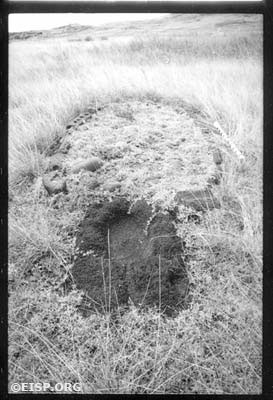
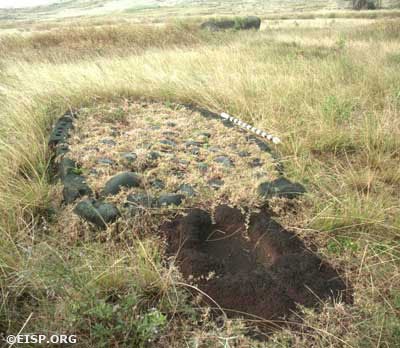 Our field crew found a very unusual oval, paved feature 32-023-004 with a partially buried oval red scoria basin incorporated. Subsequent excavation by the University of Chile revealed an extended burial dated to the 1600s. Rapa Nui (Easter Island) Photos taken in 1984 and 1989 by David C. Ochsner, © EISP/JVT.
Our field crew found a very unusual oval, paved feature 32-023-004 with a partially buried oval red scoria basin incorporated. Subsequent excavation by the University of Chile revealed an extended burial dated to the 1600s. Rapa Nui (Easter Island) Photos taken in 1984 and 1989 by David C. Ochsner, © EISP/JVT.
Posted on May 3rd, 2009 by EISP Staff | Categories: 1980s, Field Notes & Documents |
Easter Island Statue Project History: 1983
“It was a lengthy work, for not only are the figures and ruins very numerous, but it was found that not till after some six months’ study could they even be seen with intelligent eyes.”
Katherine Routledge (1919:xi).
Goals and Methods
The overall, initial goal of the Easter Island Statue Project is the systematic documentation of the island’s major archaeological artifact: the giant moai. Consistently applied criteria describe, in a thorough and orderly manner, the attributes of each statue. It is intended that all descriptive data collected will be analyzed to formulate a stylistic typology that will be a significant aid in chronological and other studies.
Jo Anne Van Tilburg and David C. Ochsner. © EISP/JVT.
As an outcome of 1982 fieldwork, we had made changes to the basic statue attribute list, and to various categories of statue location and position. We also added categories of statue conservation data. Data collection forms were further revised for consistency and ease of use, with special attention given to the fact that the 1983 field season would be conducted with the help of University of California Research Expedition (UREP) volunteers. Architect Johannes (Jan) Van Tilburg assisted in Sessions I and IV.
The UREP plan called for four sessions of four volunteer members each. We would share a rented house in Hanga Roa. A broad range of skills and professional expertise in a variety of areas allowed volunteers to contribute to the work in meaningful ways. Participants were encouraged to contribute their own observations and speculations throughout the course of the fieldwork, and this led to a greatly enriched and expanded project.
Raúl Paoa Ika sketching. ©1983 EISP/JVT/ Photo: D. C. Ochsner.
Felipe Teao A. and Jo Anne Van Tilburg. ©1983 EISP/JVT/ Photo: D. C. Ochsner.
Perhaps most important, we had the capable assistance of Felipe Teao A. About half way through the field season Raúl Paoa Ika, an able Rapa Nui draftsman, joined us. Raúl assisted Jan in the field, and both spent long hours at a drafting table in a studio set up in our rented house. They produced valuable finished drawings and architectural plans that were a significant supplement to statue data. Marty Gonzalez and Valerie De Gier volunteered during one session each, and Marty went on to write her Masters thesis in anthropology about Rapa Nui.
Posted on May 3rd, 2009 by Jo Anne Van Tilburg, Ph.D. | Categories: 1980s |
Rano Raraku Slope, Small Moai “Little Tukuturi”
A page from Dr. Van Tilburg's field book shows the moai labeled as "Pequeno Tukuturi", with measurements.
Dr. Steve Williams, Jo Anne Van Tilburg, Dr. Frank Bock and A.J. Bock measuring Little Tukuturi with large-scale calipers.© EISP/JVT/Photo: D. C. Ochsner.
Posted on May 3rd, 2009 by EISP Staff | Categories: 1980s, Field Notes & Documents |
Ahu Akahanga 07-584
Ahu Akahanga (07-584), surveyed by EISP in 1983. Plans drawn by Johannes Van Tilburg, with conjectural reconstruction of three statues (drawn by Cristián Arévalo Pakarati) and associated with platforms 1, 3, and 4.
Ahu Akahanga (07-584) landward side. Photo by David C. Ochsner, © JVT.
Plan view of Ahu Akahanga (07-584) seaward side (top) and landward side, by Johannes Van Tilburg, 1983.
Plan view of Ahu Akahanga (7-548) with conjectural restoration of three moai, each with a different ahu construction. Plan drawn by Johannes Van Tilburg, 1983. Reconstructed statues drawn by Cristian Arevalo Pakarati.
Posted on May 3rd, 2009 by EISP Staff | Categories: 1980s, Field Notes & Documents |
Ahu Akahanga 07-581
Moai 07-581-001, which fell in the process of being moved to or raised on the ahu. © 1989 EISP/JVT/Photo: D. C. Ochsner.
Ahu Akahanga, site 07-581. © EISP/JVT/Plan: Raul Paoa Ika, 1983, Drawing: Cristiàn Arèvalo Pakarati, 1989.
Posted on May 3rd, 2009 by EISP Staff | Categories: 1980s, Field Notes & Documents |
Vinapu Pukao, 02-210
EISP field sketches by Raúl Paoa of pukao (topknots) found at Vinapu, 1983. These were used in the process of visually reconstructing Moai 02-210-004.
Posted on May 3rd, 2009 by EISP Staff | Categories: 1980s, Field Notes & Documents |
Ahu Vaihu 06-255
EISP plan showing the projected line indicating the curvature of the seaward wall, Ahu Vaihu (6-255), by Raúl Paoa, 1983.EISP field sketches of Ahu Vaihu (06-255) by Raúl Paoa, 1983.
EISP field sketches of Ahu Vaihu (06-255) by Raúl Paoa, 1983.
Posted on May 3rd, 2009 by EISP Staff | Categories: 1980s, Field Notes & Documents |
Measuring Calipers
Andy Anderson and Jo Anne Van Tilburg improvising with bamboo poles as measuring devices, Easter Island (Rapa Nui). DCO/JVT.
Design sketch for first set of measuring calipers by Johannes Van Tilburg.
Posted on April 15th, 2009 by EISP Staff | Categories: 1980s, Field Notes & Documents |
Bas-relief Dorsal Designs
Bas-relief dorsal design on the back of an upright statue, Ahu Nau Nau, Anakena, Easter Island (Rapa Nui). DCO/JVT
Detail of a similar but more complex design on the back of a fallen and broken torso, Ahu Oroi, Rapa Nui (Easter Island), 1983. Drawn by Raúl Paoa, EISP.
Posted on April 15th, 2009 by EISP Staff | Categories: 1980s, Field Notes & Documents, Sculpture Embellishment |
Easter Island Statue Project History: 1982
“There is still much to be done before all of the questions attendant on the statues of Easter Island can be answered. Little can be accomplished by theoretical approaches to the solution of the problem. What is now needed is a comprehensive and systematic field study and recording of the statues, followed by extensive excavations both in Rano Raraku and in other parts of the island.”
Arne Skjølsvold
Goals and Methods
The field goal of EISP is to accomplish 100% documentation of every moai on the island and in museum collections. The initial research goal was to collect enough data to create a formal and stylistic typology that, it was hoped, would be a significant aid in chronological studies. The first field season of EISP was in 1982. The first basic survey document was the Atlas Arqueológico de Isla de Pascua. The second was a list of 55 statue attributes isolated by Chilean archaeologists Cristinio F. and P. Vargas C. of the Centro de Estudios.
Jo Anne Van Tilburg and rented Land Rover.
This was pre-digital fieldwork, of course, and precision and accuracy were big concerns. The first step was to create two recording forms. The first form was a two-page format for use in the field. On this, diagrams were drawn which clearly indicated where the measurements were to be taken. Dimensions were arranged on the diagrams in convenient groupings, and all measurements were taken at a given point or general area of the statue before moving on. Since I was working alone most of the time, the chief concern was to facilitate the work in an orderly fashion, as well as to minimize contact and avoid possible damage to the friable surface of the stone.
[Read More…]
Posted on April 14th, 2009 by Jo Anne Van Tilburg, Ph.D. | Categories: 1980s |
Sketch of Rano Raraku Exterior Quarry
Rano Raraku Exterior Quarry by Johannes Van Tilburg. ©1982 EISP/JVT
Posted on April 14th, 2009 by EISP Staff | Categories: 1980s, Field Notes & Documents |
Rano Raraku Exterior Quarry: Moai sketches and neck tracings (RR-002-077)
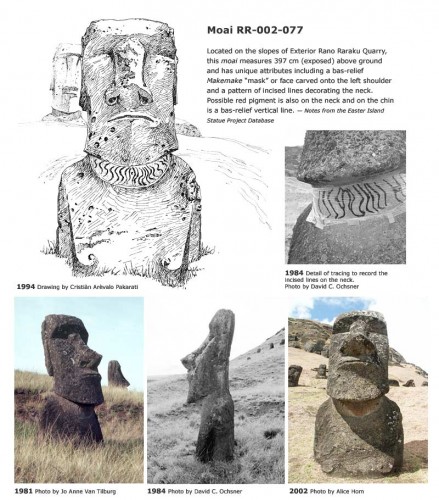
Moai RR-002-077 Located on the slopes of Exterior Rano Raraku Quarry, this moai measures 397 cm (exposed) above ground and has unique attributes including a bas-relief makemake ‘mask’ or face carved onto the left shoulder and a pattern of incised lines decorating the neck. Possible red pigment is also on the neck and on the chin is a bas-relief vertical line. — Notes from the Easter Island Statue Project Database
Posted on April 14th, 2009 by EISP Staff | Categories: 1980s, 1990s, Field Notes & Documents, Sculpture Embellishment |
Easter Island Statue Project History: 1981
UREP Project Participants, Hanga Roa, Mataveri Airport, (left to right) Joan Seaver, Marcia Opel, Joanne Weinhof, Georgia Lee, Jo Anne Van Tilburg, Esther Schwartz, Ron Hoskinson. Photo by: Johannes Van Tilburg/EISP
In the summer of 1981, Jo Anne Van Tilburg was a member of the University of California Research Expeditions Program (UREP). Led by Georgia Lee and conducted under the auspices of Chile’s Council of Monuments, the goal of the six-week volunteer project was to investigate the nature and extent of the island’s corpus of rock art.
Rock art recording on Easter Island consisted of making photographs and scale drawings at about 25 petroglyph sites and one painted site. Some sites were damaged, and others had been previously recorded in one way or another. At the major tourist sites of Anakena, Tongariki, and Orongo, we made rubbings.
Posted on April 13th, 2009 by Jo Anne Van Tilburg, Ph.D. | Categories: 1980s, Rock Art |
